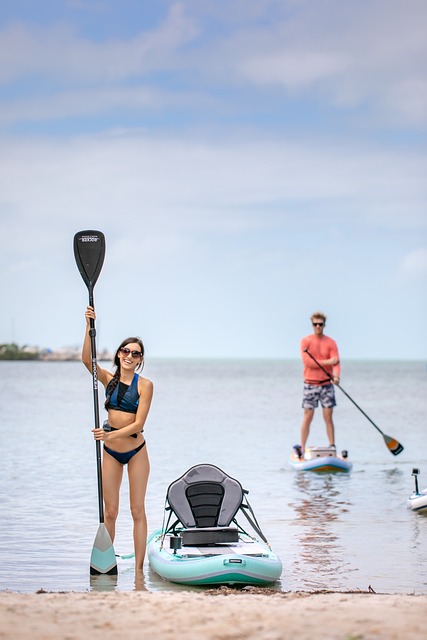Inflatable paddle boards (iSUPs) offer a versatile and accessible entry point into the world of paddle sports for people of all skill levels. They are durable, portable, and suitable for a variety of water conditions, making them an excellent choice for recreational paddling, yoga, fishing, and more. When selecting an iSUP, consider factors such as size, shape, material, and intended use to ensure you choose a board that meets your specific needs. Opt for high-quality materials like PVC-coated nylon or military-grade PVC, and look for features like drop stitch construction, a US box fin system, and comprehensive accessories including a repair kit, pump, paddle, and storage bag to enhance performance, maintenance, and convenience. Remember to maintain your iSUP by cleaning it after each use, storing it in a safe environment away from direct sunlight and extreme temperatures, and regularly inspecting it for any damage or leaks to prolong its lifespan.
Exploring the versatility of watersports, inflatable paddle boards (iPaddles) have emerged as a popular choice for enthusiasts worldwide. This article navigates through the essentials of iPaddles, from their fundamental aspects to the nuances of material quality and design variations that cater to diverse paddlers. Compare performance between hard and inflatable options, and discover what sets high-quality iPaddles apart. We’ll guide you through top market brands and indispensable accessories to elevate your experience on the water. Proper maintenance ensures longevity, and our tips aid in selecting the perfect iPaddle for your unique needs, making waves in the world of paddle boarding.
Understanding Inflatable Paddle Boards: The Basics

Inflatable paddle boards, often abbreviated as iSUPs, have become a popular alternative to traditional hardboards due to their versatility and convenience. These boards are constructed with durable, high-pressure materials such as PVC and drop-stitch fabric, which allow them to hold their shape on the water while remaining lightweight and portable. The inflatable nature of these paddle boards means they can be easily transported and stored, making them an excellent choice for those with limited space or who prefer to travel with their gear. When inflated, they provide a stable and reliable platform for paddling, whether on calm lakes, gentle rivers, or in the ocean’s smaller swells. The variety of lengths available in inflatable paddle boards caters to different rider weights, skill levels, and intended uses, from yoga and fishing to touring and surfing.
Selecting the right length for an inflatable paddle board is crucial as it affects performance, stability, and maneuverability. Shorter boards are typically more maneuverable and better suited for smaller riders or those interested in dynamic activities like SUP yoga or surfing. In contrast, longer boards offer increased speed and tracking ability, making them ideal for touring or larger riders who seek a straight, unwavering line across the water. The choice of length also depends on the intended use case; for instance, a 10 to 12-foot board is often recommended for all-around use, while 12- to 14-foot models are preferred for longer distances and cruising. Regardless of the chosen length, inflatable paddle boards deliver a compelling experience for enthusiasts looking to enjoy the sport across various environments and conditions.
Inflatable Paddle Board Materials and Durability: What to Expect

When considering an inflatable paddle board for your aquatic adventures, understanding the materials and their implications for durability is paramount. High-quality inflatable paddle boards are typically constructed with PVC (polyvinyl chloride) material, which is known for its robustness and resistance to punctures and abrasions. The thickness of the PVC layers can vary, with most reputable boards featuring a minimum of three layers: an outer layer for UV and wear protection, a reinforcement layer for added strength, and an inner core layer that provides rigidity and shape retention when inflated. This multi-layered construction ensures that the board can endure a variety of conditions, from calm lakes to challenging ocean swells.
Inflatable paddle boards are designed with durability in mind, incorporating materials like military-grade PVC or drop-stitch construction, which consists of thousands of interwoven threads that keep the board firm and prevent it from bending excessively. These materials not only make the board puncture-resistant but also ensure longevity and stability during use. Additionally, the inflatable nature of these boards means they are self-repairing to an extent; small dings or scrapes can often be worked out by adjusting the pressure in the board, thus maintaining its performance over time. When properly maintained and stored, an inflatable paddle board can provide a reliable and long-lasting platform for paddlers of all levels.
Design Variations: Finding Your Perfect Match in Sizes and Shapes

When embarking on a journey across tranquil waters or navigating through playful waves, finding the inflatable paddle board that aligns with your specific needs is paramount. The world of inflatable paddle boards offers a plethora of design variations tailored to accommodate different rider preferences and environments. For those who prioritize stability and space for gear, longer inflatable paddle boards are available, providing an extended platform that enhances tracking and makes them ideal for touring or longer excursions. On the other hand, shorter models are perfect for maneuverability in tight spaces or surf-oriented activities where agility is key. Each size and shape offers a unique ride experience, ensuring there’s an inflatable paddle board to suit every type of paddler and water condition. Whether you’re an avid adventurer, a casual paddler, or a family looking for a shared experience, the right inflatable paddle board awaits to offer unparalleled performance and enjoyment on the water.
Performance Comparison: Hard vs. Inflatable Paddle Boards

When evaluating the performance of hard versus inflatable paddle boards, several factors come into play, each influencing the paddle board’s handling and user experience. Hard paddle boards, often made from materials like fiberglass or carbon fiber, provide a more direct transfer of energy due to their rigid composition. This trait can be advantageous for experienced paddlers seeking performance and speed on flatwater or in surf conditions. The lack of flex in these boards also contributes to their responsiveness during turns and maneuvers, making them suitable for racing or technical waterways where precision is key.
In contrast, inflatable paddle boards offer a versatile alternative that has gained popularity among both novices and seasoned paddlers alike. Inflatable SUPs, or iSUPs, are constructed with durable drop-stitch materials that maintain their shape when inflated, ensuring they retain the rigidity necessary for optimal performance. This design provides a balance between stability and agility, making them user-friendly for various environments, including lakes, rivers, and even light ocean swells. The portability of iSUPs, due to their deflated state when transported, offers convenience for those with limited vehicle storage space or who travel frequently. Additionally, the buoyancy and floatation properties of inflatable paddle boards can make them a safer choice for riders of all skill levels. When considering the performance comparison between hard and inflatable paddle boards, it’s clear that both have their merits, and the choice ultimately depends on individual preferences, intended use, and specific environmental conditions.
Features of High-Quality Inflatable Paddle Boards

When exploring the waterways, an inflatable paddle board (iSUP) offers a versatile and accessible option for both novices and seasoned paddlers alike. High-quality inflatable paddle boards are designed with robust materials such as PVC or durable drop-stitch fabrics that ensure rigidity and longevity even when inflated to the recommended pressure. These iSUPs are typically available in various lengths, ranging from compact models perfect for maneuvering through tight spaces to longer versions ideal for tracking straight over open waters.
The features of a high-quality inflatable paddle board extend beyond its construction materials. They often include an integrated fin system that enhances directional stability and speed. The fins can be detached for easy transport and storage, making these boards incredibly user-friendly. Additionally, the deck pad is usually ergonomically designed to provide a comfortable, anti-slip surface, ensuring safety and comfort during your paddling adventure. Accessory attachments like bungee cords are also commonly featured, allowing paddlers to securely carry gear for extended excursions. These boards often come with a carrying backpack, making the process of transporting them from one location to another a breeze. High-quality inflatable paddle boards are engineered to offer an exceptional on-water experience, combining durability, performance, and convenience for paddlers of all skill levels.
Top Brands in the Market: A Consumer's Guide

When exploring the world of inflatable paddle boards, discerning consumers are often faced with a myriad of options from top-tier brands that cater to diverse preferences and skill levels. Among the most recognized names in the market, paddle board enthusiasts frequently turn to brands like iRocker, which offer a range of products that are renowned for their durability and performance on the water. The iRocker series, available in various lengths, includes models designed for all types of paddlers, from beginners to seasoned veterans. Each board is engineered with high-quality materials, ensuring stability and maneuverability regardless of the rider’s weight or experience.
Another prominent player in the inflatable paddle board arena is the brand SereneLife, which provides an excellent balance between quality and affordability. Their boards are crafted to accommodate a wide range of users, from individuals seeking a casual paddle to those looking for a robust companion for yoga or fishing on the water. With options that span different lengths, these boards offer varying levels of stiffness and width, allowing for personalized performance and comfort. When selecting an inflatable paddle board, it’s crucial to consider factors such as the intended use, storage space, and transportation ease, which are all addressed by the leading brands in this dynamic market segment.
Inflatable Paddle Board Accessories: Enhancing Your Experience

An inflatable paddle board (iSUP) offers a versatile and accessible entry point into the world of paddle sports, catering to enthusiasts of all skill levels. With the advent of high-quality, durable materials such as PVC and drop-stitch construction, iSUPs have become a robust alternative to their rigid counterparts. The market abounds with a variety of inflatable paddle board accessories designed to enhance your on-water experience, from beginner to expert. A selection of paddles, leashes, fins, and boards tailored to different conditions and preferences ensures that every paddler can find the right equipment to match their needs.
Furthermore, a range of additional accessories like waterproof cases, GPS trackers, action cameras, and specialized bags for transporting your iSUP further enrich the experience. These tools not only aid in safety and performance but also allow users to document and share their adventures with ease. Whether you’re an adrenaline junkie seeking the thrill of surfing waves or a tranquility seeker aiming to glide across mirror-like waters, inflatable paddle board accessories can elevate your journey on the water, making each outing both enjoyable and memorable. The adaptability of these accessories means that as your skills develop or your interests evolve, your iSUP setup can grow with you, ensuring a consistent and engaging experience every time you hit the water.
Maintenance and Care for Your Inflatable Paddle Board

An inflatable paddle board, or iSUP, is a versatile and convenient watercraft that offers the same performance as a traditional hardboard but with added portability and storage advantages. To maintain your iSUP in optimal condition, regular care and maintenance are essential. Begin by thoroughly rinsing your board with freshwater after each use to remove saltwater, sand, or any residue that could accelerate wear and tear on the material. Store your iSUP in a cool, shaded area away from direct sunlight and extreme temperatures, which can compromise the integrity of the inflatable structure. Regularly check the valve and seams for any signs of damage or leaks, and address them promptly to maintain the board’s air retention capabilities. When inflating, aim to reach the recommended pressure as indicated by the manufacturer; overinflation can strain the seams, while underinflation may affect the board’s performance. Additionally, after a prolonged period of inflation, it’s wise to deflate your iSUP and allow it to fully dry to prevent mold or mildew growth. Proper care and maintenance will extend the life of your inflatable paddle board and ensure safe and enjoyable outings on the water.
Tips for Selecting the Best Inflatable Paddle Board for Your Needs

When selecting an inflatable paddle board that suits your needs, consider factors such as size, shape, material, and intended use. The length of an inflatable paddle board plays a crucial role in its performance and stability; shorter boards offer greater maneuverability for experienced paddlers, while longer boards are more stable and suitable for touring or larger individuals. The width affects stability; wider boards are more stable but may sacrifice some speed. Pay attention to the thickness as well, as it influences buoyancy and how much weight the board can support.
Material quality is another significant aspect to consider when choosing an inflatable paddle board. High-quality materials typically mean a durable board that can withstand frequent use and environmental elements. Look for boards made from PVC-coated nylon or military-grade PVC, as these materials are known for their durability and resistance to punctures and abrasions. Additionally, inspect the drop stitch construction, which is responsible for the rigidity of the board when inflated. A fin system compatibility is also important; ensure that the board comes with a US box fin system or adapts to one, as this offers better tracking and maneuverability. Finally, consider accessories such as a repair kit, pump, paddle, and storage bag, which are essential for maintenance and convenience when on the water.
